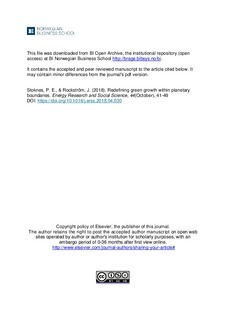Redefining green growth within planetary boundaries
Journal article, Peer reviewed
Submitted version
Permanent lenke
http://hdl.handle.net/11250/2558077Utgivelsesdato
2018Metadata
Vis full innførselSamlinger
- Publikasjoner fra CRIStin - BI [1015]
- Scientific articles [2173]
Originalversjon
Energy Research & Social Science. 2018, 44(October), 41-49. 10.1016/j.erss.2018.04.030Sammendrag
Over the last decade, green growth policies have drawn increasing interest. OECD, UNEP, the World Bank and the EC have had several initiatives on the issue, and the Nordic countries have a special program on it. Definitions and indicator sets have been developed, though critics have pointed out that most initiatives amount to little more than a greenwashing of conventional economic growth. The paper proposes and discusses two definitions of green growth, one weak and one strong. Both build on resource- and carbon productivity measures, but whereas the weak definition requires absolute decoupling, the strong or “genuine green growth” requires sufficient decoupling to achieve science based targets for planetary boundaries. The approach is tested at country levels, starting with the climate boundary, by analyzing progress on carbon productivity (“CAPRO”) in Nordic countries since 2000. Results show that so far, among Nordic countries, Sweden, Finland and Denmark have achieved genuine green growth, while Norway has not. Implications for policy and communication of green growth are discussed.
